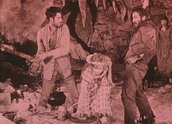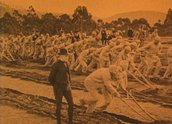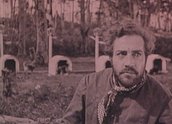


For the Term of His Natural Life (1927)
Synopsis
Richard Devine (George Fisher), heir of wealthy Sir Richard, decides to ship out of England, rather than reveal his mother’s secret – that his real father is the neighbour, Lord Bellasis (Arthur Greenaway). When Bellasis is killed by his own son, John Rex (also played by George Fisher), Richard Devine gets the blame. He invents the name Rufus Dawes to spare his mother’s shame and is transported to Van Diemen’s Land (Tasmania) for his crimes. The ship carries Major Vickers (Gerald Kay Souper), his wife (Katherine Dawn) and daughter Sylvia (Beryl Gow), as well as the ambitious and cruel Lieutenant Maurice Frere (Dunstan Webb), who is second-in-command. Nursemaid to the child is Sarah Purfoy (Jessica Harcourt), who plots to free her husband, none other than John Rex, who has been sentenced for forgery. The plot fails because Dawes overhears and warns the captain.
Six years later, Vickers is now in charge of the penal settlement at Macquarie Harbour, where Dawes, Rex and the notorious murderer Matt Gabbett (Arthur McLaglen) are prisoners. Lt Frere arrives to inform Vickers that the prisoners are to be transferred to the new prison at Port Arthur. Dawes attempts suicide by throwing himself into the sea. He survives and stumbles ashore to find three people marooned on the coast. John Rex has taken control of the small ship transferring Mrs Vickers and Sylvia to Port Arthur. Rex has left them and Lt Frere to starve on the coast, but Dawes helps them by building a boat. Mrs Vickers dies before they are rescued. Sylvia adores ‘Good Mr Dawes’, but the trauma robs her of her memory. When they are rescued, Frere denounces Dawes, out of jealousy. Dawes is returned to prison.
Five years later, Sylvia and Frere are engaged to be married in Hobart. John Rex, now recaptured, stands trial, but Frere lies and saves him from the gallows, fearing that Sarah Purfoy – now a successful innkeeper – will reveal his own debauchery. Rufus Dawes is sent back to Port Arthur, where a sympathetic pastor, Reverend North (Mayne Lynton), tries to help him. John Rex and the notorious cannibal Gabbett lead another escape, aided by Sarah. Rex finally returns to England, where he impersonates the long-lost Richard Devine. Rufus Dawes is transferred to Norfolk Island, where Frere eventually succeeds in breaking his spirit. The Rev. North finally confesses his secret to Dawes – he saw the murder of Lord Bellasis 19 years earlier in England and kept quiet about it, because of his own peccadilloes. He helps Dawes to escape on a ship, carrying Sylvia Vickers, who’s now estranged from Frere. A huge storm wrecks the skip, but Sylvia’s memory returns as she recognises her 'Good Mr Dawes’. They kiss on a life raft, as currents carry them towards land.
Curator’s notes
For the Term of His Natural Life was an epic production – more expensive and ambitious than anything made in the silent era in Australia and symbolic of the tensions within the industry. It was a banner production of ‘The Combine’, the dominant force in the Australasian cinema business, and it was a considerable success with Australian audiences. The problem was that it was always intended to be more than that. The original director, Raymond Longford, was asked to step aside for Norman Dawn, a Hollywood director who had come to Australia to make scenic travelogues. Dawn was an expert in special effects, action and working in difficult locations, such as Alaska, but he was no match for Longford in direction of actors or the subtle mechanics of storytelling. That Australasian Films (‘The Combine’) gave Dawn the reins on this high-profile film of an Australian classic shows that subtlety was not what they were after. They wanted a picture that American distributors would buy, because it had an American director – albeit one who was certainly not of the first rank. In the end, it did not matter who directed it – the film’s US prospects were destroyed by the arrival of a reliable means of delivering sound on film. Australasian spent £70,000 making For the Term of His Natural Life in 1927, an unheard-of sum for the times (see Australasian Gazette – 70,000 Pounds Production Nears Completion, 1926), but they took a severe loss on the film because no-one foresaw that the introduction of sound was about to change everything.
Whether the film would have succeeded in the US without this is hard to say. It was old-fashioned even for 1927, in terms of story and acting style. The best directors in Hollywood were producing infinitely more subtle work – which may have been why Norman Dawn was making polar adventures in Alaska and travelogues in Australia in the first place. To be fair to him, the task of adapting Marcus Clarke’s book was a difficult one, and Dawn made a reasonable fist of it. He is said to have dumped Longford’s script and worked directly from the book. The plot is a mid-Victorian jumble of coincidences, aliases and hidden revelations of inheritance, enlivened by Marcus Clarke’s much more serious purpose – the documenting in fiction of the realities of convict life in the Australian colonies.
Clarke was a journalist on the Melbourne Argus, a well-respected newspaper when he joined it in 1867, at the age of 21. The first version of the novel began to appear as a serial in the Australian Journal in February 1870, under the title His Natural Life. Clarke was editor of the journal at the time. He had visited Port Arthur in Tasmania, and based many of the episodes in the book on true stories. Gabbett, for example, is based on Alexander Pearce, who escaped from Macquarie Harbour in 1822 with seven other prisoners – all of whom he is believed to have eaten.
The first film of the book was made in 1908; another in 1911. This 1927 version was originally to cost £15,000 and star Frank Harvey. Having failed to make much impact with The Pioneers (1926), his first film for Australasian, Longford proposed the remake of For the Term of His Natural Life as a modestly budgeted production that would have sales appeal in the UK. Australasian’s ambitions for the film appear to have grown once they saw Longford’s script and with the knowledge that a ‘Hollywood’ director was available. The budget was increased to £40,000 once Longford stepped aside (which must have been galling for him, since he had continually pleaded for more money on earlier productions), and it kept growing during production, as Dawn took a crew to Port Arthur and Macquarie Harbour in Tasmania, and various locations along the NSW coast.
The use of these locations is probably the film’s strongest asset, lending both veracity and visual impact. The other real strength of the film is its confident use of special effects. Norman Dawn invented some of these during his long apprenticeship in Hollywood – notably the use of glass shots (in which a painted glass is suspended between lens and action to add scenic detail to the settings). Dawn used a glass shot to put a roof on the roofless buildings of Port Arthur, for instance (see clip two). Dawn also imported American actors for the main roles, adding to the controversy that surrounded the film.
Newspapers and politicians had denounced the choice of an American to direct an Australian classic. In Australian Cinema: the First Eighty Years, Graham Shirley and Brian Adams write that the Tasmanian Royal Society and a Tasmanian bishop were concerned at the sensationalising of the grislier aspects of the story. A senator urged the Customs Minister to bar the film’s export; another said the theme of Australia’s convict past was best forgotten. The Sydney Truth accused Dawn of being ‘party to the slaughtering’ of Australia’s young film industry, by spearheading an American invasion. The same kinds of comments have been made in recent decades about other American productions in Australia.
The National Film and Sound Archive restored For the Term of His Natural Life in 1981, using two different versions of the film: an incomplete Australian release print, and a shortened US release version (consisting of takes not used by the Australian release) preserved by the American Film Institute. The 1981 version used still photographs and footage from other sources to fill in gaps where the original footage was lost. The tinting is an approximation of the way the original film would have looked, based on the Australian release print. A new score was recorded, based largely on the original accompaniment as detailed on a surviving music cue sheet for the film.
- Overview
- Curator’s notes
- Video 3 clips
- Principal credits
- Find a copy
- Comments 1
- Map
- Add your review



